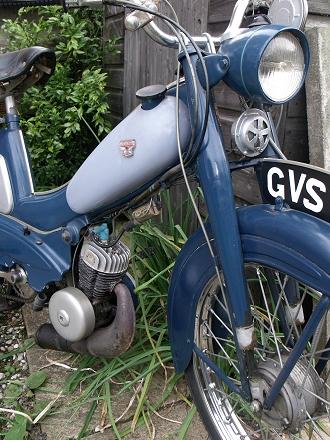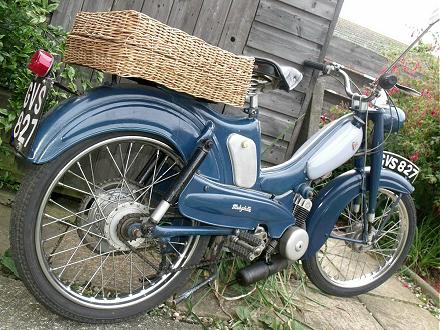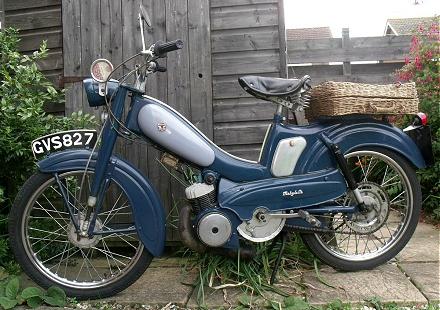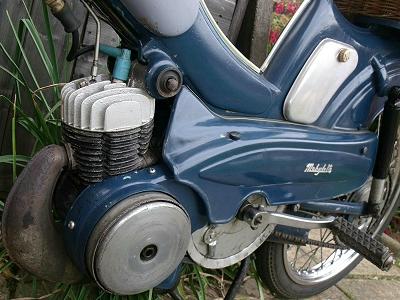Motobécane’s AV88 was a model primarily created for sales into ‘restricted performance’ markets, particularly France and America and, despite being listed over a 10-year period in the UK, proved a less popular model since it was largely eclipsed by its more powerful and faster ‘Big Brother' AV89. While the AV89 is fitted with a big-port cylinder, 9:1 compression ratio head, H14mm carburettor, and is rated at 2.7bhp, our ‘Little Brother’ appears positively weedy by comparison with a split-fin standard-port cylinder, a miserable 6.5:1 compression ratio head (which was carried over from the old AV78), a frugal AR10mm carburettor, and rated at … about 1.5bhp we guess?
The cylinder head disc shows serial number 2803184 and, since the bike was UK-registered in October 1961, we would probably have been expecting a continuous-fin 1.4bhp cylinder to be fitted, but this split-fin 1.7bhp cylinder carries the same engine number, so these certainly look like the original components. (Raleigh first notified dealers about the ‘new’ 1.7bhp split-fin engine in Raleigh Service Memoranda No.7 dated 1st April 1963.) This low power engine is then fitted into the same frame as the AV89, with the same swing-arm rear suspension, but telescopic forks instead of Big Brother’s leading-link front fork at the time … yes, this could represent a fair bit of metalwork for such a low power motor to be dragging around, so there’s immediately some apprehension that the AV88 is likely to be a pretty poor performer.
 With our feature machine dated at 1961, the first thing to do
is look at further differences beyond just the motor
specification. There have to be a number of these to
account for the selling price comparison at the time: AV88 =
£76–19s–6d, AV89 =
£85–19s–6d. The seat is pretty obvious,
AV89 had a dual-seat, where AV88 has just a single saddle, but
look closer for another associated subtle difference … AV88
has no rear footrests, which would normally be mounted off the
rear suspension unit shrouds, so AV88 wears a different set of
‘economy’ rear shocks with no footrest
fittings. Instead of the pillion seat the rear frame is
topped with a pressed steel carrier, which in the case of our
example carries a wicker basket. Notice the early style of
‘arched’ rear mudguard; the AV89 had already replaced
that with a ‘squared-valance’ guard even while it
still had the band-suspended leading-link fork set.
With our feature machine dated at 1961, the first thing to do
is look at further differences beyond just the motor
specification. There have to be a number of these to
account for the selling price comparison at the time: AV88 =
£76–19s–6d, AV89 =
£85–19s–6d. The seat is pretty obvious,
AV89 had a dual-seat, where AV88 has just a single saddle, but
look closer for another associated subtle difference … AV88
has no rear footrests, which would normally be mounted off the
rear suspension unit shrouds, so AV88 wears a different set of
‘economy’ rear shocks with no footrest
fittings. Instead of the pillion seat the rear frame is
topped with a pressed steel carrier, which in the case of our
example carries a wicker basket. Notice the early style of
‘arched’ rear mudguard; the AV89 had already replaced
that with a ‘squared-valance’ guard even while it
still had the band-suspended leading-link fork set.
AV88 certainly wears a big rear sprocket! Count the teeth on that shark! 54! AV89 has a standard 48T rear sprocket to give a high drive ratio to match its higher power output for a greater speed. AV88 is running a 12.5% lower drive ratio, which is quite a lot of gearing down! The larger rear sprocket also means that it would be too big to fit into AV89’s fully enclosed chain case so, basically, there isn’t one, just a half-length chain case backplane to function as a splash guard, preventing water being thrown directly onto the chain runs by the wheel. This gives a lightness and cost economy necessitated by the larger rear sprocket.
88 has the same alloy, full width 8-rib × 100mm Prior hubs as 89, but the front brake plate is the leading-link type ‘cross pattern’ alloy brake plate, and we’ve never before seen this fitted to a telescopic fork set. This means the brake lever faces forward instead of back, and the cable routing is completely different. The rear brake plate is also changed, just a conventional, old style, 100mm plain alloy disc type instead of AV89’s special cast brake plate to suit the fully enclosed chain guard set. The difference makes sense, but it’s almost as if the AV88 was built using up cheap old leftover parts?
OK, we think that’s pretty much it with the differences, so what we basically have with the AV88 is a low powered motor in a relatively heavy frame, but geared down to compensate for the loss of power. Weights for the dual-seat AV89 were given around 90lb and the AV88 about 86lb, but one may doubt those figures since Raleigh quoted the RM5 (AV89 equivalent) at 112lb, and even the lightweight RM11 Super Tourist weighed in at 102lb. Though some of the cycle fittings are cheaper on 88, and maybe it is actually a few pounds lighter than the 89, any small weight difference of a few pounds is unlikely to have any performance effect worthy of consideration.
 Starting is the familiar old Moby procedure, fuel tap pushed
down for on. We opt for a flying start on this occasion
since the centre stand has ‘settled’ too much to
‘kick-start’ on the stand; so twistgrip forward to
decompress, thumb the trigger choke under the left-hand bar,
pedal away. The motor spins, twist back the throttle
… and 88 fires right away, a couple of coughs as it seems
indecisive whether it wants choke or not, then clears its lungs
and we’re away. The initial acceleration quite takes
us by surprise! We weren’t expecting it to pull that
well from a start! It’s immediately obvious what a
difference that larger rear sprocket makes, though we’re
also expecting 88 to run right out of breath as the speed picks
up, but it doesn’t seem to do that within the urban area,
snapping readily up to an indicated 25, then on to 30 …
hold on, this doesn’t feel like 30? A wave summons
our pace rider to attendance for a comparative check, and sure
enough, our 60mph Huret is
already reading over 5mph
fast, so that speedometer is probably going to be about as
accurate as a wind sock! Our outbound readings, struggling
against a light headwind with a cold motor, were all bettered by
the return-leg readings with a light tailwind and hot
motor. Best on flat (paced readings since our Huret
speedometer indications were far too fictional) 30mph outbound, 32mph inbound. Downhill run (long
shallow slope), pace 38 (indicated 48/49), following uphill climb
(short/steep ascent) dropped to 15mph over the crest. Second downhill
run (short/steep descent), wow: indicated 50mph! (Only to be crushed by our
pacer confirming this was actually only 40), following uphill
climb (long shallow slope) dropped to 18mph over the crest.
Starting is the familiar old Moby procedure, fuel tap pushed
down for on. We opt for a flying start on this occasion
since the centre stand has ‘settled’ too much to
‘kick-start’ on the stand; so twistgrip forward to
decompress, thumb the trigger choke under the left-hand bar,
pedal away. The motor spins, twist back the throttle
… and 88 fires right away, a couple of coughs as it seems
indecisive whether it wants choke or not, then clears its lungs
and we’re away. The initial acceleration quite takes
us by surprise! We weren’t expecting it to pull that
well from a start! It’s immediately obvious what a
difference that larger rear sprocket makes, though we’re
also expecting 88 to run right out of breath as the speed picks
up, but it doesn’t seem to do that within the urban area,
snapping readily up to an indicated 25, then on to 30 …
hold on, this doesn’t feel like 30? A wave summons
our pace rider to attendance for a comparative check, and sure
enough, our 60mph Huret is
already reading over 5mph
fast, so that speedometer is probably going to be about as
accurate as a wind sock! Our outbound readings, struggling
against a light headwind with a cold motor, were all bettered by
the return-leg readings with a light tailwind and hot
motor. Best on flat (paced readings since our Huret
speedometer indications were far too fictional) 30mph outbound, 32mph inbound. Downhill run (long
shallow slope), pace 38 (indicated 48/49), following uphill climb
(short/steep ascent) dropped to 15mph over the crest. Second downhill
run (short/steep descent), wow: indicated 50mph! (Only to be crushed by our
pacer confirming this was actually only 40), following uphill
climb (long shallow slope) dropped to 18mph over the crest.
 Overall the AV88 performed surprisingly better than we might
ever have imagined. As a result of the variator
transmission and low overall drive ratio, acceleration is fairly
capable up 25mph, so 88 makes
a reasonably effective ’ped for urban use. The
general ride, handling and brakes proved more effective than many
other period economy commuter mopeds we ride, and from a starting
point of expecting to be slating the 88 by the end of our
run–we’re surprised to report, it did go quite
well! The low power motor expectedly fades pace on hills,
but it confidently got up every ascent without calling for any
pedal assistance, so we’ve got to fairly report that it
capably did the job.
Overall the AV88 performed surprisingly better than we might
ever have imagined. As a result of the variator
transmission and low overall drive ratio, acceleration is fairly
capable up 25mph, so 88 makes
a reasonably effective ’ped for urban use. The
general ride, handling and brakes proved more effective than many
other period economy commuter mopeds we ride, and from a starting
point of expecting to be slating the 88 by the end of our
run–we’re surprised to report, it did go quite
well! The low power motor expectedly fades pace on hills,
but it confidently got up every ascent without calling for any
pedal assistance, so we’ve got to fairly report that it
capably did the job.
The Huret speedometer was a joke; a 25% indication error at just 40mph was not the kind of ‘misread’ you could account for in anything pertaining to call itself an ‘instrument’. You’d get more accurate readings off a kiddie’s plastic watch from a Jamboree bag!
The lights were … well … dull and inadequate by today’s standards, but typical of the time and adequate to be seen by, so would probably be considered fair for their day back in 1961.
 The AV88 Mobymatic (Mk2) was priced
£76–19s–6d from its initial UK listing in November 1960. (The
Mk2 aspect related back to the older ‘plunger’ AV78
model, which originally introduced the ‘Mobymatic’
name, hence the 88 technically became its ‘Mk2’
replacement. Comparatively the AV89 Luxamatic at this time
was priced at £85–19s–6d.
The AV88 Mobymatic (Mk2) was priced
£76–19s–6d from its initial UK listing in November 1960. (The
Mk2 aspect related back to the older ‘plunger’ AV78
model, which originally introduced the ‘Mobymatic’
name, hence the 88 technically became its ‘Mk2’
replacement. Comparatively the AV89 Luxamatic at this time
was priced at £85–19s–6d.
The AV88 listed through 1961, though was not represented in the UK line-up for 1962, seemingly replaced by a single-seat AV89 Luxamatic at £85–19s–6d, while the dual-seat AV89 rose to £89–19s–6d. AV88 appeared to return again for 1963, now as the Mobymatic De Luxe priced at £84–19s–6d with the single-seat AV89 still at just £1 more.
1964 now found an AV88D Duomatic model (for dual-seat) priced £87–19s–6d, while the single-seat AV89 was now £94–19s–6d. The AV88 was listed right up to the ‘B-Duomatic’ model in 1970, and then quietly fell off the radar. It was only ever an ‘also-ran’ model in the UK, and is rarely encountered, which goes as some indication that not so many were sold into the British market.
Of recent times however, more AV88s appear to be turning up as people seem to be bringing back cheap ‘grey imports’ from France, as the French no longer seem to have so much interest in old mopeds that now require registration and are subject to standardised regulative European demands.

